In the field of high-temperature insulation and protection, ceramic fiber is widely used due to its excellent high-temperature resistance, corrosion resistance, and low thermal conductivity. It is commonly applied in industrial furnaces, heat treatment equipment, pipelines, and high-temperature equipment linings. To fully utilize the exceptional performance of ceramic fiber, the correct installation method is crucial. So, how do you attach ceramic fiber? This article will introduce several common installation methods for CCEWOOL® ceramic fiber.
1. Adhesive Installation
Adhesive installation is a common method for ceramic fiber, especially for small equipment or high-temperature pipes with flat surfaces. During installation, a special high-temperature adhesive is applied to attach the ceramic fiber material to the surface of the equipment. The adhesive should be evenly spread to ensure a tight bond between the ceramic fiber and the substrate, achieving optimal insulation. This method is typically used for ceramic fiber boards and paper.
2. Anchor Pin Fixing
For industrial equipment linings that require high-strength insulation and wear resistance, anchor pin fixing is one of the most commonly used methods. During installation, anchor pins are welded onto the steel structure of the equipment, and the ceramic fiber blanket or module is fixed onto the pins, forming a solid lining system. This method enhances the tensile strength of the ceramic fiber and ensures its stability and long-term performance in high-temperature environments.
3. Mechanical Fixing
Mechanical fixing is often used for the installation of ceramic fiber module systems. Special metal hangers or brackets are used to hang the ceramic fiber modules directly onto the steel structure of the equipment. This method is quick and efficient, suitable for large furnace linings or heat treatment equipment, ensuring a tight bond in high-temperature environments and reducing heat loss.
4. Pre-formed Insert
For complex-shaped high-temperature equipment, pre-formed inserts are an ideal installation method. Pre-formed inserts are ceramic fiber materials processed into specific shapes to fit particular parts of the equipment. During installation, the pre-formed ceramic fiber is directly embedded into the equipment, ensuring a tight fit. This method significantly reduces seams, improving overall insulation performance.
5. Hybrid Installation
In some complex high-temperature equipment, a combination of multiple installation methods may be used. For example, adhesive installation can be used on flat surfaces, while anchor pins or mechanical fixing can be employed in curved areas or where more wear resistance is required. This flexible installation method provides better insulation and structural stability depending on the equipment's needs.
CCEWOOL® ceramic fiber is the preferred insulation material for high-temperature equipment, thanks to its excellent heat resistance, low thermal conductivity, and superior thermal shock resistance. The correct installation method is key to maximizing the insulation and protection provided by ceramic fiber, ensuring efficient equipment operation.
Post time: Oct-29-2024


